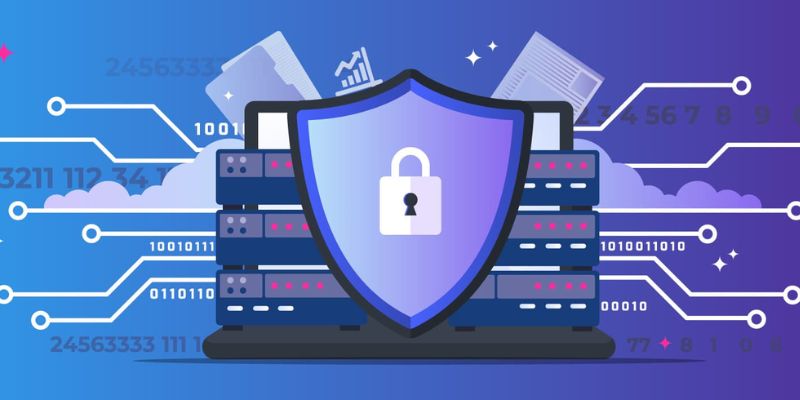Blockchain Security Unveiled: Is Your Digital Fortress Impenetrable?
Let’s cut to the chase – in a world buzzing with digital threats, how secure is blockchain? You’ve heard the hype; blockchain is the latest stronghold in cyber defense. But just like any fortress, its strength depends on its design and the guards at its gates. I take you inside the layers of blockchain’s armor, from robust encryption to cryptographic hashing that keeps your data locked tight. We’ll explore the resilience of consensus algorithms and how they keep the ledger safe, no cracks allowed. And if worst comes to worst, we delve into the strategies to fend off and recover from blockchain exploits. Pull up a chair, because we’re breaking down the walls and showing you whether your digital fortress can truly withstand the onslaught.
Unpacking the Layers of Blockchain Security Measures
The Strength of Encryption in Blockchain
In blockchain, encryption acts like magic armor. It keeps your coins safe. It turns data into secret codes. Only folks with a special key can read it. This way, no one can steal or change your information. Blockchain uses strong encryption. It’s hard to crack. Everyone on the network helps to check each other. So, it’s like having a giant team of guards.
Understanding Cryptographic Hashing Functions
Cryptographic hashing is like a secret handshake. It turns information into a short code. This code gets checked a lot. If just one letter changes, the code changes a lot. This is good for safety. It stops others from making fake codes that look real. Blockchain uses this to keep all data true and safe. Each block gets its own unique code. Once made, nobody can change it. This is what makes blockchain so tough to break.
Now remember, each piece on its own is strong, but all of them together make the blockchain very hard to attack. It’s like a fortress with high walls, moats, and guards. Each part does its job to keep the whole castle safe. Blockchain puts many layers between your data and the bad guys. This helps everyone trust the system. Even without knowing who else is using it. It’s smart, strong, and does a lot of safety checks. This way, you can sleep easy knowing your digital gold is safe.
Exploring the Resilience of Consensus Algorithms and Ledger Safety
Ensuring Consensus Algorithms Reliability
In blockchain, trust is not just a word; it’s in the code. The process that makes this happen is called a “consensus algorithm.” This is how all the computers in a network agree on what’s true and what’s not. Just like kids playing tag agree on who’s ‘it,’ these algorithms set the rules for the blockchain game.
But wait, why should we care? Because if they don’t work right, things can go wrong—like real wrong. Imagine you send some digital cash to buy a bike, but the network messes up and it’s like you never sent it. Or worse, it says you did when you didn’t! That’s what can happen if consensus algorithms fail.
To keep these algorithms strong, we check them like a detective looking for clues. We test how they act when lots of users join the game or when some try to cheat. It’s like making sure your fort can stand up to friends crashing your party or a windstorm.
Next, we have ledgers, the heart where all blockchain memories live. They must be safe as a secret diary. They’re supposed to last forever, unchanged—immutable, we call it. If they change when they’re not meant to, that’s like someone rewriting your diary to say you love broccoli when you actually hate it!
So, we protect ledgers by locking them with advanced math—encryption. This math is so tough; it’s like a lock that takes a super genius years to break. And just like your bike has a lock, the blockchain has a copy of this lock on every page of the ledger. Someone would have to break each lock to mess with your stuff. Good luck with that!
Lastly, we play defense with security audits. These are like check-ups at the doctor but for the blockchain. They help find any weak spots before they become big problems, like catching a cold before it turns into pneumonia. Then we fix them up and make them strong again.
Identifying and Protecting Against Digital Ledger Vulnerabilities
Now let’s talk about keeping digital ledgers safe. We’re always on the lookout for any sneaky ways to break in. Hackers come up with new tricks, but we’ve got to be smarter. So we keep our eyes open and learn from mistakes—ours and others’. Each slip-up is a chance to get better.
One big bad wolf able to blow houses down is the “51% attack.” This is a power grab where someone gets more than half the network’s power. It’s like if one kid in the game of tag makes all the rules and says they’re never ‘it.’ Not fair, right? We stop this by making sure no one can get that much control.
We’ve also got smart contracts to worry about. These are like robot agreements that do what they’re told. But if there’s a mistake in how they’re set up, it’s like a robot making cookies but burning them every time. That’s why we double-check their code to make sure they work just right.
In short, keeping blockchain safe is a big job with many pieces. From locking down consensus algorithms to giving digital ledgers armor, every bit counts. It’s like keeping a fortress strong. With sharp minds and tough security, we’re working to make blockchain a safe place to play.
The Battle Against Blockchain Exploits: Preventions and Responses
Learning from Past Blockchain Hacking Incidents
We often hear about blockchain’s safety. But, people can still find holes to sneak through. Mining pools, smart contracts, and even trading platforms have seen their walls crack before. Study these cases and we learn a lot. Each hack teaches us new ways to bolt our doors tighter.
Remember the DAO attack? A person found a way to drain funds due to a smart contract flaw. The blockchain world got wiser from it. We learned that code should be clean, clear, and checked many times. It’s a hard lesson, but we’re better for it.
Now, we spot bugs faster. Teams are set up just to test smart contracts before they go live. Everyone’s on their toes, looking out for any weak spot a hacker might poke. Audits are not just nice to have; they’re must-haves.
Think about it like a castle. In the old days, they built tall walls. Yet invaders still got in. So, they dug moats. Added towers. They got smarter each time their defenses were tested. That’s us with blockchain now. We’re always adding to our security playbook.
Security Protocols for Smart Contracts and Decentralized Applications
Smart contracts rock because they do deals without a middleman. Your trust is in the code, not a person. But, if that code has one bug, it could be game over. That’s why security is key.
We use things like multi-signature methods. This means more than one person has to say “okay” before a deal closes. It’s like having two keys instead of one to unlock a door. This cuts the risk big time.
Then there are audits, again. Big brains pore over every line of code. They make sure it’s tough enough to stop hackers in their tracks. No stone left unturned. This keeps your digital gold safe.
We’re always on watch for that 51% attack too. That’s when a group might control more than half the network’s mining power. They could change things for their gain. But, we work hard to keep the network spread out. The more spread out, the safer.
Think of these protocols as your steel armor. It’s crafted to fit just right, strong and close to your code’s skin. It needs to be, to guard against the arrows of hackers always flying your way.
Peering into these security plans shows us one truth. Blockchain’s tough, but never too tough to work on. Every breach, every close call hands us a tool to build a sturdier wall. We’re in a cat-and-mouse game with smart minds looking to sneak in. But our job, our promise to you, is to stay steps ahead, always crafting a safer, stronger fortress for your digital world.
Balancing Accessibility and Security in Blockchain Networks
The Implications of Public vs Private Blockchain Architectures
Public and private blockchains differ a lot. Public blockchains let anyone join. They are open and decentralized. But, this openness can lead to risks. More people joining can mean more chance of bad actors. Think of it as a city park. It’s free to enter and use but sometimes, if not watched well, things can go wrong.
Private blockchains work like a members-only club. They are not open to all. Fewer people mean it’s easier to keep safe. It’s like a private garden. Only you and chosen people can enter. But, private blockchains can lack the big trust that public ones offer. This is because they’re controlled by one group, not spread out.
Both types use encryption and security measures. This is to keep the data safe. The kind of blockchain tells us how the data is protected. It guides who gets to join. People want to know their stuff is safe. They ask if others can see or change it. Both public and private blockchains can be secure. It’s like choosing between a big guard dog or a tall fence. Both keep you safe, but in different ways.
Some myths say that since public blockchains are open, they’re easy to hack. This is not true. The truth is, they can be very secure due to how they spread out data. Many computers hold the same info. To harm a public blockchain, you’d have to fool more than half at once. This is very hard, almost impossible for big ones.
Private blockchains can be less at risk for some attacks. But they need good control inside their smaller networks. If someone inside wants to cause trouble, it could be bad. They are more like putting your trust in a few skilled guards than the whole town.
In the end, blockchain gives us a new way to look at trust. It’s about sharing power but in a smart way. The blockchain needs rules that all who join agree to follow. These rules help keep it safe.
Advancements in Blockchain Security Protocols to Thwart Data Breaches
Now, we know secure blockchains don’t just happen. It takes smart design and rules. To stop data leaks, we’ve made new advances. Think of it as building a better vault every day. It’s all made to change as needed to fight off threats.
For example, we have smart contracts on blockchains. They are like self-working programs. But, they need to be safe too. We check these contracts a lot to find any weak spots before bad folks do.
We also have what’s called blockchain security audits. They are like a health check-up but for security. Experts dig deep to spot any weak places that could lead to trouble.
There’s also consensus algorithms. They are the core of blockchain’s trust. They make sure all data is agreed upon by everyone. These algorithms have to be very strong. They must work well even when things are not going smooth. We test them in all ways to make sure they’re solid.
Security in blockchain is not just a goal. It’s a long journey that never stops moving forward. We look for potential flaws and fix them. This is to keep your digital things safe. Salt to ice, these new measures aim to melt away the threats. This is how we work to keep your digital fortress strong.
Remember, in blockchain security, there’s no room for being lazy. We always wear our thinking caps. We look out for any small clues that could lead to bigger problems. In the blockchain world, the best defense is a strong, smart offense. We’re always on the watch to protect your digital world.
To wrap it up, we dove into blockchain’s tough security. We saw how encryption and strong hashing keep data safe. We learned that consensus algorithms are key, and keeping the ledger secure is a must. We also covered the smart moves to stop hackers and keep smart contracts safe. At last, we found out that the right mix of open access and tight security is crucial.
My final two cents? Staying ahead in security is a never-ending battle, but with each upgrade and smart strategy, blockchain gets one step closer to that sweet spot—rock-solid and easy to use. Remember, as tech evolves, so must our defenses. Keep learning, stay sharp, and we’ll keep our blockchains safer for everyone.
Q&A :
How does blockchain technology ensure security?
Blockchain technology offers enhanced security through its decentralized structure, where every transaction is encrypted and linked to the previous one. It ensures security by utilizing complex cryptographic techniques, creating an unalterable ledger of transactions that makes it nearly impossible to hack or alter without detection. Decentralization means every participant on the network has a copy of the ledger, greatly reducing the risk of centralized data breaches.
What makes blockchain resistant to tampering?
The tamper-resistant nature of blockchain comes from its use of cryptographic hashes, which are unique identifiers for each block. A hash is produced using the details of the block, and any alteration to the block’s data would change the hash completely, alerting the network to potential tampering. Moreover, as each block contains the hash of the previous block, it creates a chain, and altering any previous block would require recalculating all subsequent hashes, which is computationally infeasible given the power of the blockchain network.
Can blockchain be hacked or compromised?
While blockchain is designed to be secure, it is not completely impervious to hacking. However, the required effort, resources, and computational power to compromise a blockchain makes it highly deterrence for potential attackers. Security incidents related to blockchain are usually due to vulnerabilities in smart contracts, user interfaces, or centralized exchanges, rather than the underlying blockchain protocol itself.
How does blockchain compare with traditional security methods?
Blockchain security methods differ significantly from traditional security measures. Traditional systems often rely on a central authority and single points of failure, which can be more vulnerable to attacks. In contrast, blockchain uses a distributed ledger system where each participant maintains a copy of the transaction record, providing a higher level of transparency and security. It also reduces the potential impact of a single point of compromise, making it more robust against attacks.
What is the role of consensus mechanisms in blockchain security?
Consensus mechanisms are fundamental to blockchain security. They are the processes used to achieve agreement on the blockchain network about the validity of transactions. Mechanisms like Proof of Work (PoW) or Proof of Stake (PoS) ensure that all network participants follow the rules and agree on the shared ledger’s state without needing a central authority. This not only reinforces security by preventing fraudulent transactions but also ensures the integrity and immutability of the ledger.





RELATED POSTS
How to Participate in the Avail Airdrop and Earn $AVAIL Tokens Breakthrough
Avail Airdrop offers a simple...
What is Crew3? Detailed guide to join and participate
Crew3 is a community platform...
What is the Swell Airdrop? Detailed guide to participation
The Swell Airdrop is an...
Smart Contracts: Unlocking Efficiency and Security in Transactions
Advantages of smart contracts -...
Challenges of Using Decentralized Learning Platforms: Is Blockchain the Solution?
Exploring the Challenges of Decentralized...
What Is a Crypto Exchange? Exploring Different Types and Their Functions
Looking to invest in the...
Ongoing Research Projects in Blockchain: Decoding Tomorrow’s Tech Revolution
Explore ongoing research projects in...
Overview of Andrew Tate’s crypto wallet
Uncover the secrets of Andrew...
Cow DAO base L2 chain launch: Faster, cheaper and more scalable blockchain
The Cow DAO Base L2...
Blockchain Layer 1: The Foundation of Decentralized Technology and U2U Network’s Vision
Blockchain technology has revolutionized the...
The Tokenomics of U2U Network – Sustainable Value for Users and Investors
The Tokenomics of U2U Network...
Why is Solana Going Up – Unveiling 3 Potentials of Solana
Why is Solana Going Up?...
Messari Crypto: A powerful tool for investors
In the world of cryptocurrency,...
A Night of Luxury – DePIN Alliance Yacht Party
The Depin Alliance Yacht Party...
Join the NODEPAY Airdrop today – Easy to Earn Points
Looking to explore the world...
Vulnerabilities Identified: Is Your Smart Contract Exposed?
Critical smart contract security issues...